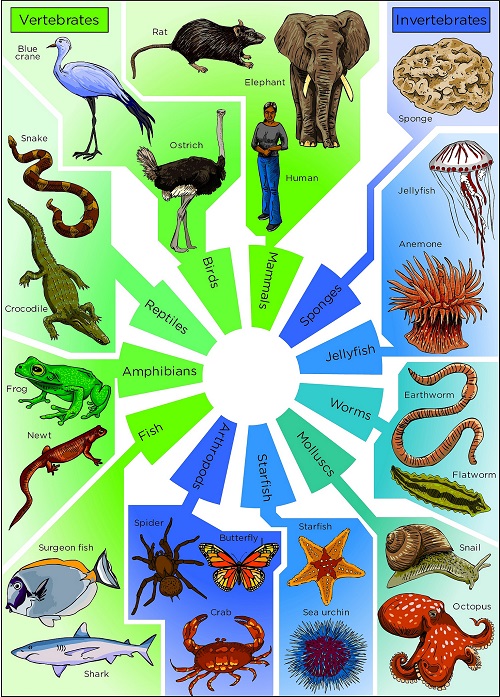Difference between vertebrates and invertebrates
Vertebrates and invertebrates are all animals. However, the term vertebrate is much more specific, describing all animals within the sub-phylum (a level of the biological classification system, which divides organisms based on common features) Vertebrata, than invertebrate which refers to all other animals.
Vertebrates include animal groups such as mammals, birds, reptiles, amphibians, sharks and bony fish, whereas invertebrates include many other animal types such as insects, mollusks, spiders, worms, jellyfish and crustaceans.
As may be expected by comparing a specific sub-phylum with all other animals there are many more invertebrates than vertebrates. It is estimated that there are around 1,300,000 invertebrate species, with many more undiscovered; the majority of which are insects. This is compared with around 65,000 vertebrate species of which around 5,000 are mammals1.
Physical Characteristics
The defining characteristic of vertebrates is the presence of a segmented, mobile vertebral column. In humans this can be seen with the individual vertebrae linking together to make the spine. Invertebrates lack this structure although they may have structures which display a similar appearance.
Another key feature associated with vertebrates is the presence of gills. In lower vertebrates these are maintained throughout development and are fully functional. In higher vertebrates the gills form during development, but transition into other structures such as the jaws or bones of the ear.
The majority of vertebrates also display two sets of paired appendages, although these may become vestigial and disappear as in snakes, but this is not a requirement of vertebrates,
Symmetry
A major difference between vertebrates and invertebrates is the symmetry that their bodies display. All vertebrates are bilaterally symmetric, meaning that they display an external mirrored appearance to their left and right side, however, interior organs are not necessarily symmetric.
Invertebrates can display radial, the organism only has a distinct top and bottom no left or right, spherical, the organism displays no distinct top or bottom, or left and right, and bilateral symmetry. In some instance such as sea sponges or slugs they can even display asymmetry.
Size
Another notable difference between vertebrates and invertebrates is the average size. Whilst there are some large invertebrates such as giant jellyfish the majority are small, much smaller than vertebrates. The vertebral column of vertebrates is key in allowing them to grow too much larger sizes. The internal skeleton based around the vertebral column allowed vertebrates to develop large, complex bodies with the associated specialized systems required to support them such as the respiratory or digestive systems. Comparatively, invertebrates will be limited, simple invertebrates will not be able to grow large as they lack the systems required to support a large body size. Some invertebrates have developed alternative systems which have allowed them to grow bigger but are still limited compared to vertebrates.
Insects and crustaceans have developed an exoskeleton (external) inside which complex systems can be protected and the systems required to move can be attached. However, exoskeletons only allow growth up to a certain point beyond which systems required to move the organism become too large to fit within the exoskeleton. In vertebrates with their internal skeleton, muscles, bones and bodies can develop up to a much larger size.
- Difference between vertebrates and invertebrates - July 14, 2016
- Difference between Flonase and Nasonex - June 23, 2016
Search DifferenceBetween.net :
Leave a Response
References :
[0]The Starting Point for Conservation Action. The IUCN Red List of Threatened Species. < http://www.iucnredlist.org/technical-documents/red-list-documents> (2012).
[1]https://www.flickr.com/photos/121935927@N06/13578745783

